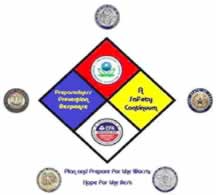9.2 Appendix 2 – EPA After-Action Report
 EMERGENCY RESPONSE REVIEW
EMERGENCY RESPONSE REVIEW
Teris LLC Explosion and Fire, El Dorado, Arkansas
FINAL REPORT, March 28, 2005
Steve Mason
EPA Region 6, Emergency Readiness Team
Response & Prevention Branch,
1445 Ross Avenue, Dallas Texas
75202
214-665-2292
mason.steve@epa.gov
The Environmental Protection Agency (EPA) Region 6 is issuing the Emergency Response Review as part of its ongoing effort to protect human health and the environment by responding effectively to chemical accidents. Emergency Response Reviews are designed to:
- Review with a local community and state officials the response procedures and outcomes to a specific chemical accident, affecting that community;
- Share information about chemical response safety practices;
- Develop potential recommendations and lessons learned to more effectively respond to an accidental release in the future;
- Build cooperation among local, state, and federal government agencies.
Emergency Response Reviews are entirely voluntary and may include all local, state and federal entities involved with the response, as well as the responsible party and their representatives.
This document does not substitute for EPA's regulations, nor is it a regulation itself. It cannot impose legally binding requirements on EPA, states, or the regulated community, and may not apply to a particular situation based upon circumstances. This guidance does not represent final agency action, and may change in the future, as appropriate.
Summary of Incident
On the morning of January 2, 2005, a report to the National Response Center indicated an explosion and fire has occurred at the Teris LLC facility in El Dorado, Arkansas. The initial explosion occurred at approximately 0800 hours.
The facility reported initially that an employee attempted to extinguish a small fire within a warehouse storing various waste containers, but that the fire soon grew out of control.
The cause of the accident is not addressed within this report.
Response organizations (El Dorado Fire and Police Departments, as well as the Union County Sheriff Department) quickly responded and established a unified command with the Teris personnel to establish a strategy and response procedures for dealing with the emergency.
Local responders closed nearby streets, as well as evacuating approximately 200 residents downwind from the facility.
EPA Region 6 dispatched its Airborne Spectral and Photographic Environmental Technology (ASPECT) plan to monitor the plume. Preliminary review of the data collected by ASPECT showed low concentrations of trimethylamine in the immediate downwind plume. No other significant compounds or concentrations were detected.
Fire fighting was conducted by Teris personnel on-site, with off-site assistance from the local response organizations.
Due to the reactive wastes involved in the fire, water was not used as an extinguishing agent. Efforts focused on cooling areas not involved in the fire, as well as movement of materials not involved.
By 1900 hours on January 2, local officials lifted part of the evacuation area. By 1600 hours on January 3, all evacuations and road closures were lifted.
On-going monitoring of the ambient air was conducted by the Center for Toxicology and Environmental Health (CTEH), who was contracted by Teris. Additionally, EPA START contractors monitoring throughout the community.
No significant concentrations of contaminants were detected during the air monitoring efforts. CTEH did detect elevated levels of particulate matter immediately adjacent to the scene.
Sampling was conducted by Teris, with EPA and Arkansas Department of Environmental Quality (ADEQ) coordination, from fire suppression runoff. These samples were to be analyzed to determine proper disposal of this water runoff.
Additionally, wipe samples were collected by Teris (CTEH), in coordination with EPA, ADEQ, and Arkansas Department of Health (ADH) at 10 locations within the community.
Teris contracted with a remediation company (HEPACO) to relocate drums not involved in the fire, as well as remediation of the warehouse after the fire is extinguished.
EPA discontinued air monitoring and demobilized from the scene on January 6. Teris continued to work with local response officials, as well as ADEQ and ADH, on remediation efforts.
A review of the response was scheduled on conducted by EPA with State and local officials on
All attendees at the review agreed that the response was handled professionally and to the best of the capabilities of the local response officials.
Any additional information inquiries concerning this response should be directed to:
Floys McAdoo, El Dorado Fire Department, 870-863-8129
or
Observations/Recommendations
|
Response teams to a disaster scene have a responsibility to first protect themselves and their team members. If you or your team is injured, not only are the number of victims increased, but the response is now delayed, resulting in additional resource utilization. This delay and need for additional resources due to your inability to keep yourself and your team protected could cost other victims their lives. DISASTER Paradigm: Safety and Security
Basic Disaster Life Support Manual, Version 2.5 At an incident, safety should be the first concern of any responder. When fire fighters, police officers or emergency medical technicians become injured or contaminated, they become part of the problem, instead of the solution. It's unfair to ask first responders to risk their life, health or the health of their families by becoming contaminated at an incident. Difficult decisions need to be made and risks taken should be weighed against the possibility of a positive outcome.
|
Observation/ |
|
Observation/ Recommendation #3 |
|
Observation/ Recommendation #4 |
|
Observation/ Recommendation #5 |
|
Each of the emergency response reviews conducted within Region 6 show one consistent pattern: Emergency response personnel within Region 6 are to be commended for their professionalism and sincere desire to protect the citizens of their communities.
Region 6 EPA is grateful for the efforts made by all emergency response personnel, and hopes the above recommendations can be used to improve the response and preparedness readiness of the community, if a future emergency occurs.
February 6, 2006
Publication #FHWA-HOP-08-014